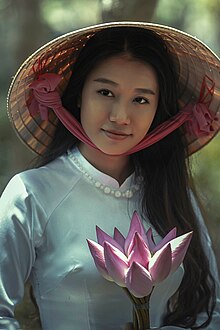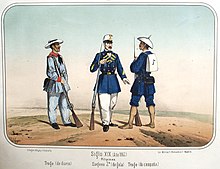


The Asian conical hat is a simple style of conically shaped sun hat notable in modern-day nations and regions of China, Vietnam, Korea, Japan, Philippines, Indonesia, Malaysia, Thailand, Cambodia, Laos, Myanmar, Bangladesh, India, Nepal, and Bhutan. It is kept on the head by a cloth or fiber chin strap, an inner headband, or both.
Regional names
English terms for the hat include sedge hat, rice hat, paddy hat, bamboo hat, and—historically but now only offensively—coolie hat.
In Southeast Asia, it is known as do'un (ដួន) in Cambodia; caping or seraung in Indonesia; koup (ກຸບ) in Laos; terendak in Malaysia; ngop (งอบ) in Thailand; khamauk (ခမောက်) in Myanmar; salakót (ᜐᜎᜃᜓᜆ᜔), sarók, sadók, s'laong, hallidung, kallugong, and tabungaw among other names in the Philippines; and nón tơi or nón chằm lá in Vietnam.
In East Asia it is called dǒulì (斗笠, literally meaning a "one-dǒu bamboo hat") in China; kasa (笠) in Japan; and satgat (삿갓) in Korea.
In South Asia, it is known as jaapi in Assam (India); in Bangladesh it is known as mathal (মাথাল).
Use
Asian conical hats are, throughout Asia, primarily used as a form of protection from the sun and rain. When made of straw or other woven materials, it can be dipped in water and worn as an impromptu evaporative cooling device.
China
In China, it was typically associated with farmers, while mandarins wore tighter circular caps, especially in the winter. There are several conical hat types worn during the Qing dynasty (see Qing official headwear).
Japan
Main article: Kasa (hat) A straw cone hat worn by a Japanese buddhist monk
A straw cone hat worn by a Japanese buddhist monk Japanese jingasa worn by samurai
Japanese jingasa worn by samurai
It is also widely understood in East Asia, most notably Japan, where they were known as kasa, as a symbol of Buddhism, as it is traditionally worn by pilgrims and Buddhist monks in search of alms.
Sturdier, even metal, variants, known as jingasa (battle kasa), were also worn by samurai and foot-soldiers in Japan, as helmets.
Philippines
Main article: Salakot

In the Philippines, the salakót is more commonly a pointed dome-shape, rather than conical, with a spike or knob finial. Unlike most other mainland Asian conical hats, it is characterized by an inner headband in addition to a chinstrap. It can be made from various materials including bamboo, rattan, nito, bottle gourd, buri straw, nipa leaves, pandan leaves, and carabao horn. The plain type is typically worn by farmers, but nobles in the pre-colonial period (and later principalia in the Spanish period) crafted ornate variations with jewels, precious metals, or tortoiseshell. These are considered heirloom objects passed down from generation to generation within families.
The salakót was also commonly worn by native soldiers in the Spanish colonial army. It was adopted by Spanish troops in the early 18th century as part of their campaign uniform. In doing so, it became the direct precursor of the pith helmet (still called salacot or salacco in Spanish and French).
Vietnam
Main article: Nón láIn Vietnam, the nón lá, nón tơi (“hats”), nón gạo (“rice hat”), nón dang (“conical hat”) or nón trúc ("bamboo hat") forms a perfect right circular cone which tapers smoothly from the base to the apex. Special conical hats in Vietnam contain colourful hand-stitch depictions or words. The Huế varieties are famous for their nón bài thơ (lit. poem conical hats) and contain random poetic verses and Chữ Hán, which can be revealed when the hat is directed above one's head in the sunlight. In modernity, they have become part of Vietnam's national costume.
Others
In India, Bangladesh and Borneo, the plain conical hat was worn by commoners during their daily work, but more decoratively-colored ones were used for festivities. In Sabah, the colorful conical hat is worn for certain dances while in Assam they are hung in homes as decoration or worn by the upper classes for special occasions.
Gallery
-
 A decorative Assamese jaapi constructed with bamboo while the decorations are felt, threads and tin glitter
A decorative Assamese jaapi constructed with bamboo while the decorations are felt, threads and tin glitter
-
 A farmer in Bangladesh wearing a mathal (মাথাল)
A farmer in Bangladesh wearing a mathal (মাথাল)
-
 A selection of conical hats in Hainan, China
A selection of conical hats in Hainan, China
-
 Souvenir nón tơi for tourists from Vietnam
Souvenir nón tơi for tourists from Vietnam
-
 Rice farmer in northern Cambodia wearing a do'un
Rice farmer in northern Cambodia wearing a do'un
-
 Conical hats of the Dusun people in Sabah, Malaysia
Conical hats of the Dusun people in Sabah, Malaysia
-
 A silver inlaid Filipino salakót
A silver inlaid Filipino salakót
-
 A Korean man in traditional mourning clothes and satgat
A Korean man in traditional mourning clothes and satgat
-
 Making conical hats (nón tơi) in Huế countryside, Vietnam
Making conical hats (nón tơi) in Huế countryside, Vietnam
-
 Three Sama-Bajau women wearing saruk from Jolo, Sulu, Philippines, c.1900
Three Sama-Bajau women wearing saruk from Jolo, Sulu, Philippines, c.1900
-
 Tortoiseshell and silver salakót from the Philippines
Tortoiseshell and silver salakót from the Philippines
-
 A Philippine Salakót
A Philippine Salakót

See also
- Fulani hat
- Gat
- List of hats and headgear
- Mokoliʻi, an island in Hawaii with a nickname "Chinaman's Hat"
- Ngob
- Pilgrim's hat
- Pointed hat
References
- "Definition of COOLIE". www.merriam-webster.com. Retrieved January 5, 2022.
- "Definition of coolie | Dictionary.com". www.dictionary.com. Retrieved January 5, 2022.
- "Coolie hat - Definition and More from the Free Merriam-Webster Dictionary".
- "Bamboo Craft". Banglapedia.
- "Conical Hats". Nguyentientam.com. Retrieved May 23, 2012.
- Chisholm, Hugh, ed. (1911). "Mandarin" . Encyclopædia Britannica. Vol. 17 (11th ed.). Cambridge University Press. pp. 55–559, see page 558, lines 3 to 5.
The term 'mandarin' is ...... only to those who are entitled to wear a 'button,' which is a spherical knob, about an inch in diameter, affixed to the top of the official cap or hat
- Peralta, Jesus T. (2013). Salakot and Other Headgear (PDF). National Commission for Culture and the Arts (NCCA) & Intangible Cultural Heritage in the Asia-Pacific Region (ICHCAP), UNESCO. p. 232.
- Nocheseda, Elmer I. "The Filipino And The Salacot". Tagalog Dictionary. Retrieved March 3, 2020.
- Antón, Jacinto (December 5, 2013). "La romántica elegancia de Salacot". El País. Archived from the original on April 3, 2017. Retrieved May 3, 2018 – via elpais.com.
- "Vietnamese Costumes: Non toi".
- মৃত্যুঞ্জয় রায় (April 17, 2022). "বাংলার মাথাল" [Mathal of Bengal]. Daily Naya Diganta (in Bengali). Dhaka, Bangladesh. Retrieved November 14, 2023.
External links
| Folk costumes | |||||||||||||
|---|---|---|---|---|---|---|---|---|---|---|---|---|---|
| Africa | |||||||||||||
| Asia |
| ||||||||||||
| Europe |
| ||||||||||||
| South America | |||||||||||||
| North America | |||||||||||||
| Oceania | |||||||||||||
| Textiles | |
|---|---|
| Traditional |
|
| Headgear |
|
| Belts and sashes | |
| Footwear | |
| Accessories |
|
| Clothing of Myanmar | |
|---|---|
| Clothes |
|
| Headgear | |
| Stitching and design | |
| Footwear | |